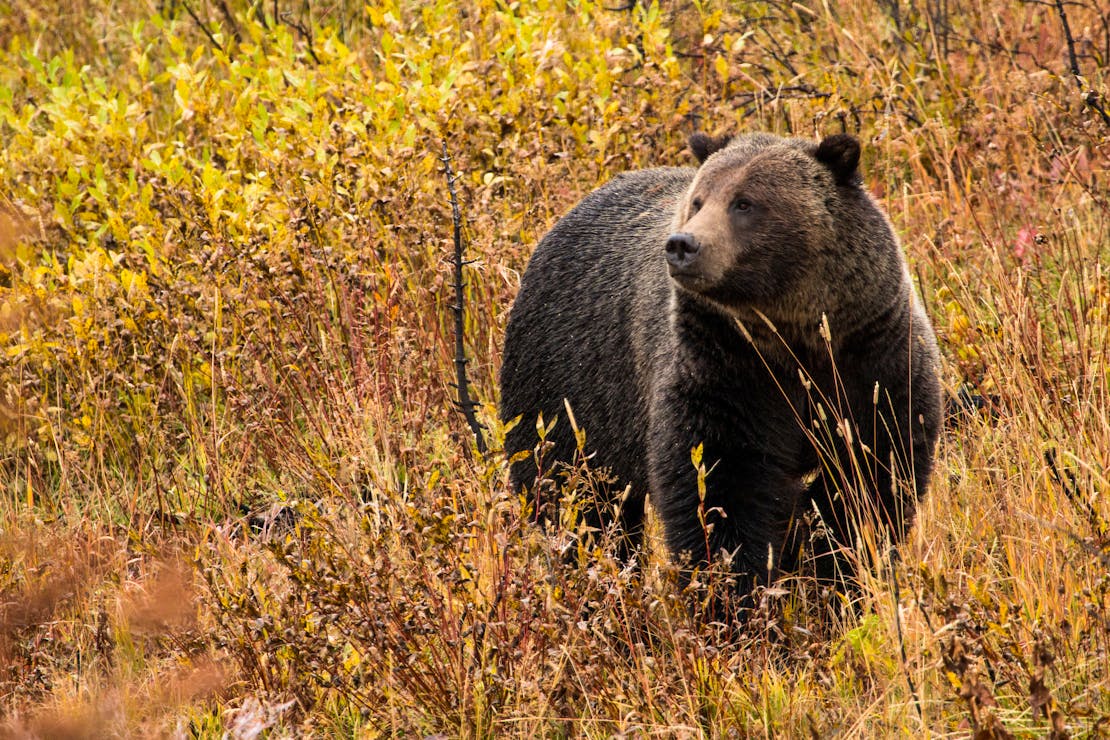2024 has only just begun, but Defenders of Wildlife has already been beary busy advocating for grizzly bears at the state and federal level. Here are some of the highlights and how we’re getting involved.
A Problematic New Law in Montana
Last year was tough for Montana grizzly bears. On December 14, the Montana Fish and Wildlife Commission approved a new grizzly bear administrative rule, or ARM, which incorporated Senate Bill 295 into law. The law states if grizzly bears are delisted as a threatened species under the Endangered Species Act, Montana Fish, Wildlife and Parks is allowed to issue a permit to someone to kill a grizzly bear if it is deemed to be “threatening” livestock.
Defenders fought against the original bill in May 2023, and continues to raise concerns over several problems. As Montana’s human populations grow, grizzly bears must navigate a rapidly expanding urban-wildlife interface that includes homes, ranches, small livestock, roads and garbage. Not every grizzly bear navigating human developed areas is a threat, but in many cases, they must pass through these developed areas to reach their habitat. Garbage, bird feeders and domestic fruit trees can entice bears into staying longer in developed areas just because they are following their noses and bellies. In this new rule, the use of the word “threatening” is far too vague. If ESA protections are removed, the new rule could open the door to unnecessary killing of bears who just happen to be present and not necessarily causing conflict.
Further, the ARM applies to both public and private lands. Public lands play an increasingly key role in providing secure, connected habitat as the landscape becomes more fragmented. Allowing the killing of grizzly bears on public lands undermines this vital role.
We acknowledge the final ARM includes a requirement that the livestock owner must have demonstrated the use of one or more non-lethal, preventative measures before a permit is given on public land. The language on non-lethal is encouraging, but we still believe permits should not be given to landowners to kill grizzly bears threatening livestock on multiple-use public land.
Bears are one of the slowest reproducing land mammals in North America. Seemingly small amounts of mortality can negatively impact a population and the likelihood of connectivity between populations.
This law will incorporate annual quotas for bear mortality, which will apply to bears inside and outside the demographic monitoring areas (see map below) for delisted populations. While the quotas may shift over time depending on the political climate, low quotas could help regulate mortality in ecosystems occurring under this new permit system. However, the potential for very high quotas allowing excessive mortality remains.
Despite our serious concerns, the final approved ARM does include a commitment that Montana will delay hunting for at least five years after delisting. We of course do not want to see any bears killed for trophies; however, this delay would provide a period for agencies and others to monitor what mortalities grizzlies will face under state management, without the added mortalities of a hunting season.
With the imperfect ARM approved, we must continue promoting best-practice coexistence and advocating for connectivity between the Northern Continental Divide, Greater Yellowstone and other ecosystems.
Final Montana Management Plan Expected
Montana Fish Wildlife and Parks is expected to unveil a final grizzly bear management plan for the state in winter 2024. Defenders provided comments on the draft plan in February 2023, noting our concerns about the lack of commitment to ecosystem connectivity and minimizing mortality of grizzly bears in-between ecosystems.
Updates from U.S. Fish and Wildlife Service
We expect FWS to release a new Notice of Intent for an updated Environmental Impact Statement for Bitterroot Grizzly Bear Recovery along the Montana-Idaho border this winter. Returning bears to the Bitterroot ecosystem is a key missing piece in grizzly bear recovery.
Further, we are waiting on FWS for its decision regarding Montana and Wyoming’s state petitions to delist the Northern Continental Divide Ecosystem and Greater Yellowstone Ecosystem grizzly bear populations. This decision is expected by early summer. Defenders submitted comments on the status review in December 2023, and remain seriously concerned about the potential ramifications of state management if ESA protections for grizzly bears are removed.
To Restore or Not Restore Grizzlies
Federal agencies are currently considering restoring grizzly bears to the North Cascades Ecosystem in Washington State. Here, they are functionally extinct. If the restoration is approved, bears from healthy source populations in interior British Columbia or the Northern Continental Divide and Greater Yellowstone ecosystems in Montana and Wyoming would be translocated. Defenders recently submitted comments clarifying our support and recommendations for improvement on the Draft Restoration Plan and Environmental Impact Statement for North Cascades grizzly bear recovery. We expect a decision this spring.
In the meantime, our field staff are working to prepare Washingtonians through educational outreach and promotion of non-lethal methods to live alongside grizzlies once more. We were also involved in helping Leavenworth, WA, become the state’s first bear smart community.
Your Role
Defenders cannot conserve these bears alone. If you live in an area with bears, read up on ways you can make your home Bear Smart. Follow Defenders to stay informed on the latest grizzly bear updates and calls action when needed.


















Follow Defenders of Wildlife
facebook bluesky twitter instagram youtube tiktok threads linkedin